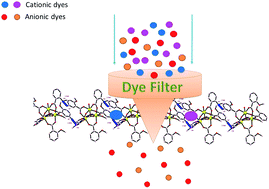Engineered Fe3 triangle for the rapid and selective removal of aromatic cationic pollutants: complexity is not a necessity†
Abstract
In this study, a low-cost oxo-bridged {Fe3} triangular cluster was constructed based on a benzoate ligand via slow evaporation. The cluster was thoroughly characterized by FTIR and UV-visible spectroscopy, TGA, and PXRD, and the exact structure was elucidated by single-crystal XRD. The formation of C–H⋯π and π–π interactions is responsible for the extra stability of {Fe3} clusters, which further enhances the dye adsorption property. The dye adsorption experiments performed on cationic [methylene blue (MB) and rhodamine-B (Rh-B)] as well as anionic [methyl orange (MO) and congo red (CR)] dyes revealed the ultimate selectivity of the present cluster towards the cationic ones. The {Fe3} cluster exclusively adsorbs the cationic dyes, i.e., MB and Rh-B even in the presence of anionic dyes, i.e., CR and MO. The extra stability, reusability and high efficiency of the {Fe3} molecular ensemble make it an attractive and fascinating material of importance. The kinetics analysis was evaluated employing different kinetics models. Furthermore, the plausible adsorption mechanism was also proposed, which suggests the interplay of cation–π and π–π interactions consolidating the efficient adsorption. Thus, the present work opens new doors for coordination chemists to further tune the structural features to modulate the adsorption/separation capacities of simple low-cost clusters for environmental protection for future efforts.

- This article is part of the themed collection: Adsorption and degradation of pollutants


 Please wait while we load your content...
Please wait while we load your content...